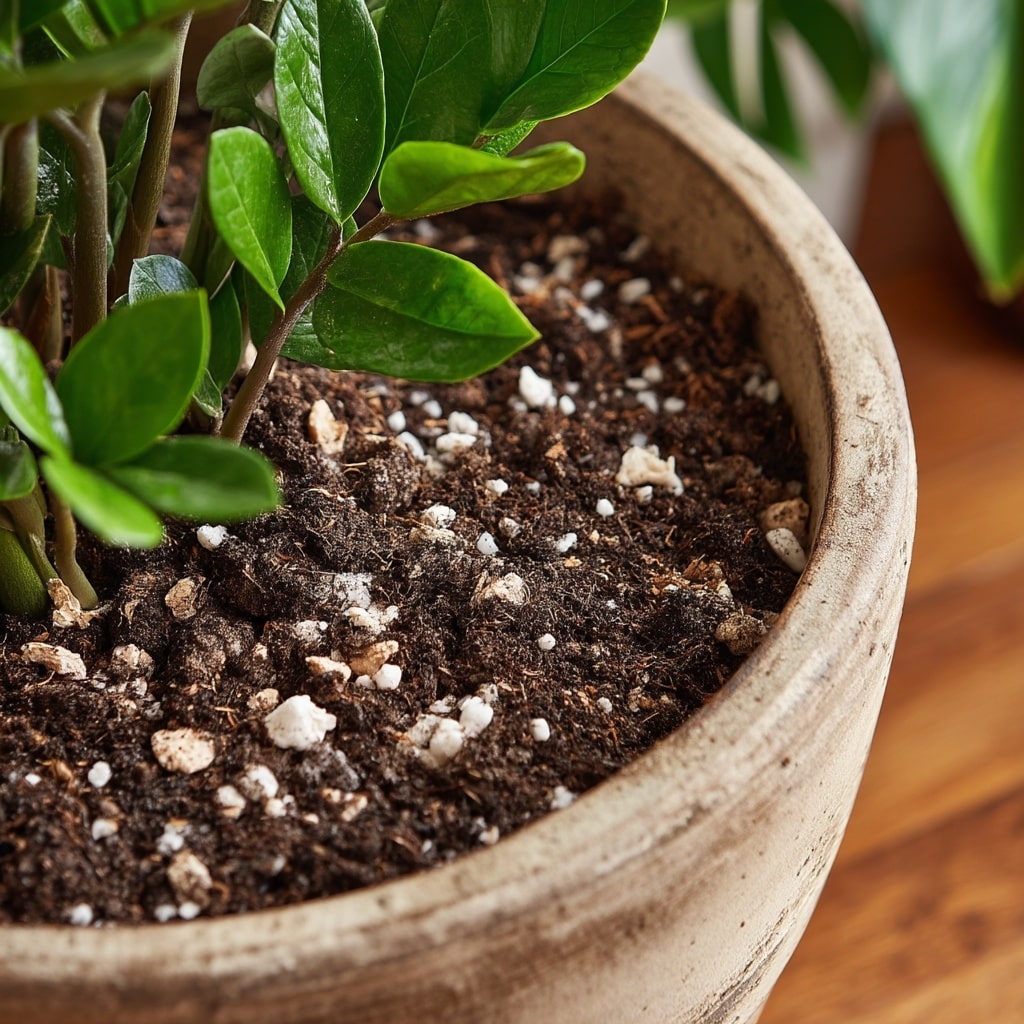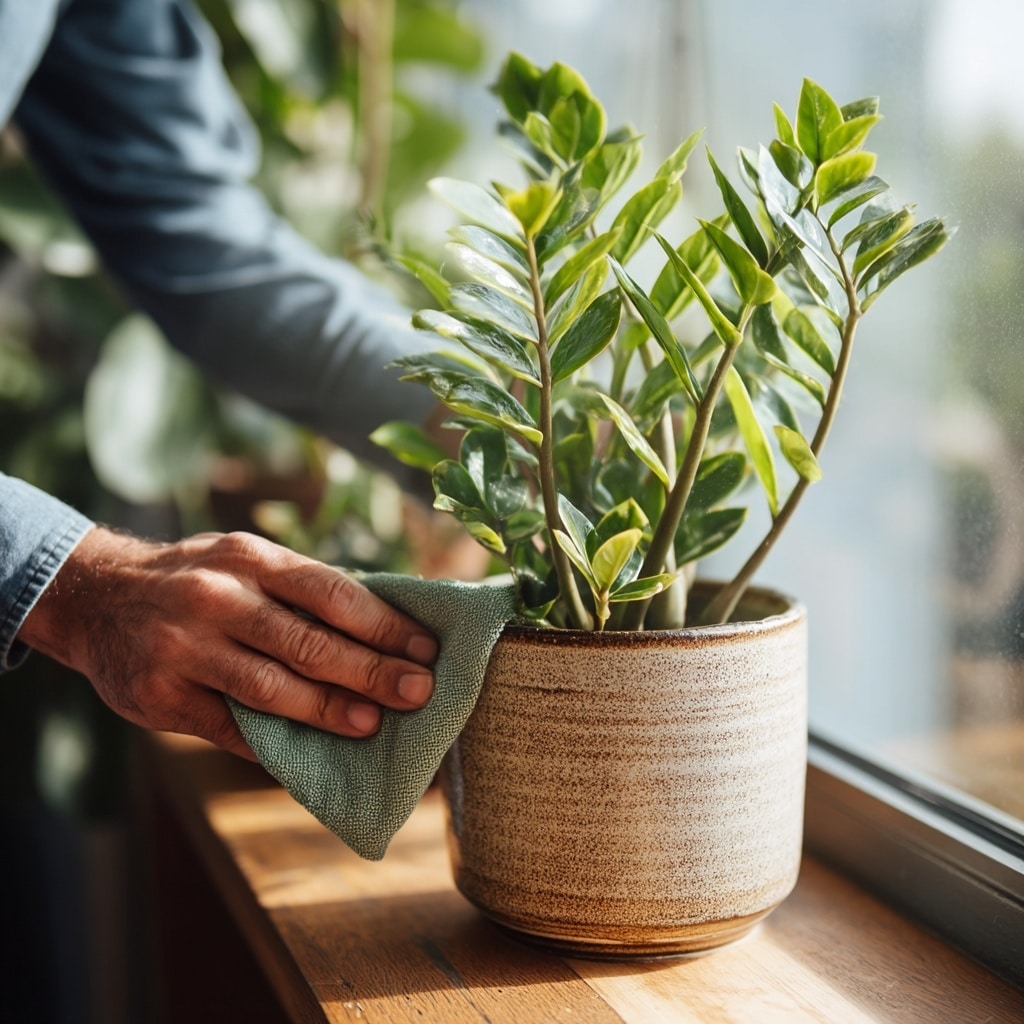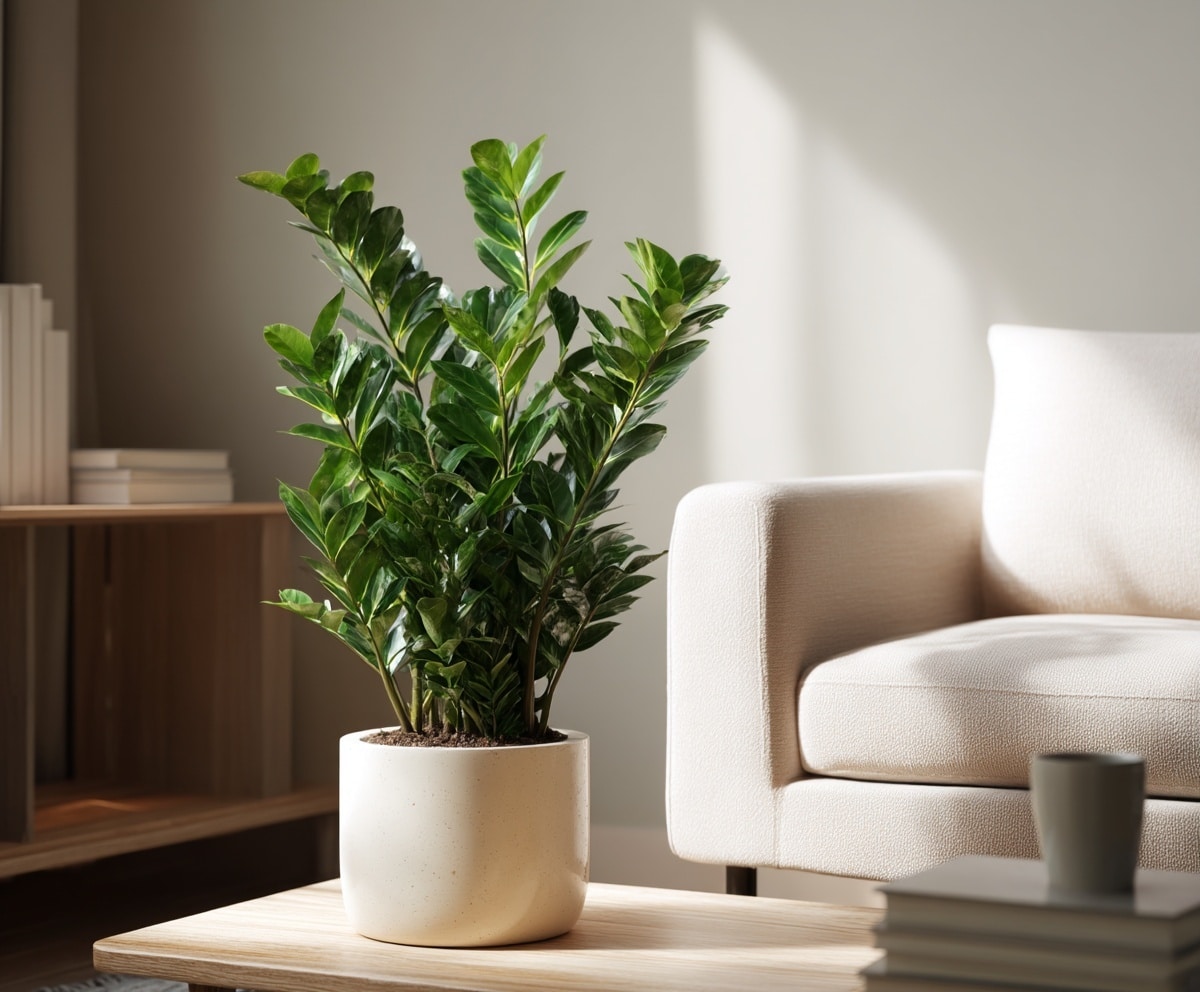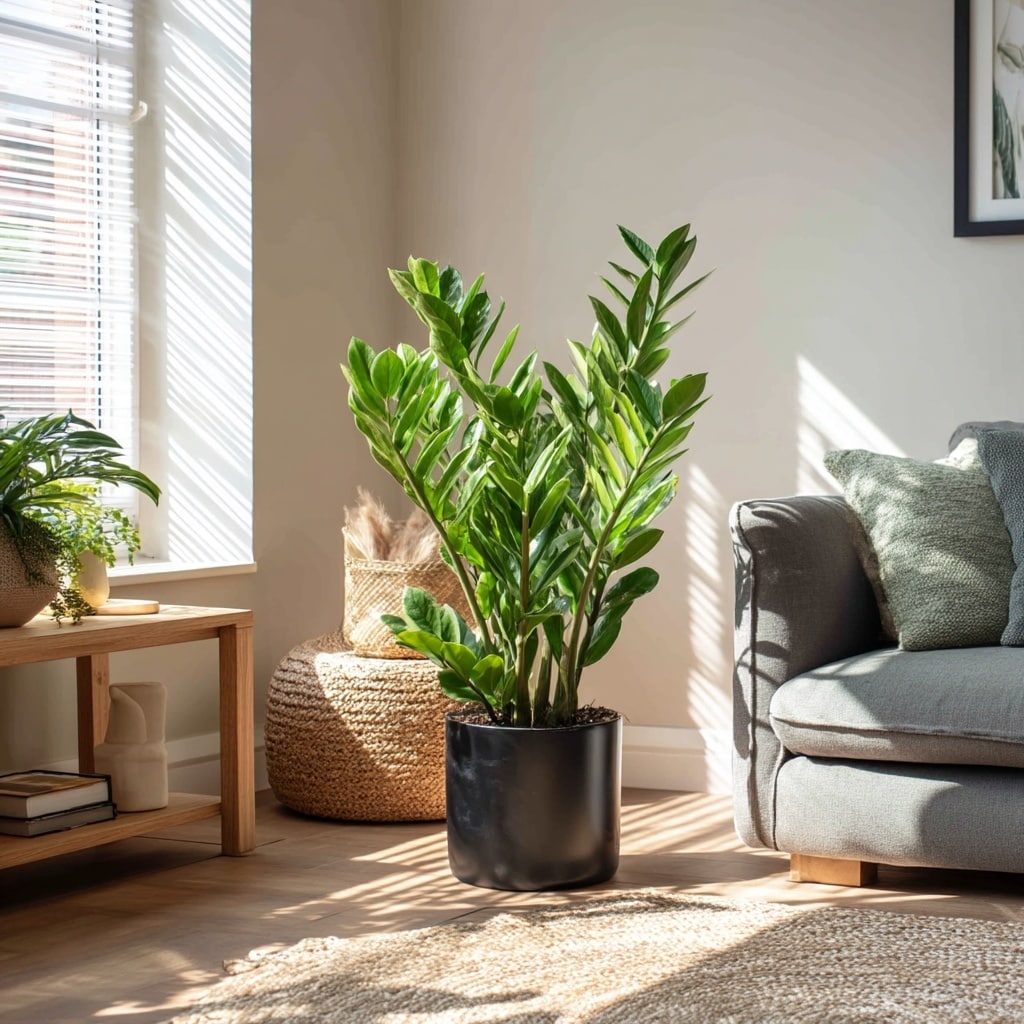ZZ Plant is one of the easiest houseplants to care for, making it a top choice for beginners and busy plant lovers alike. Known for its glossy green leaves and impressive tolerance to neglect, this tropical plant thrives in low light and requires minimal watering. The ZZ Plant, short for Zamioculcas zamiifolia, adds a sculptural touch to any indoor space while purifying the air and asking for very little in return. Whether you’ve forgotten to water for weeks or have a dimly lit corner in need of greenery, the ZZ Plant is up for the challenge.
Toxic to pets and people when ingested, it’s important to keep it out of reach, but with the right placement and a bit of basic care, this plant can thrive for decades.
Table of Contents
How to Grow a ZZ Plant Successfully
🪴 Light
The ZZ Plant is famously tolerant of low light but performs best in bright, indirect light. If it doesn’t receive enough light, the plant may become leggy, with long, sparse stems. A north- or east-facing window is ideal, but even fluorescent lighting in an office can be enough. Avoid direct sunlight—it can scorch the glossy leaves.
🌱 Soil

A well-draining, all-purpose potting mix is all the ZZ Plant needs. Look for a soil blend designed for indoor plants that includes perlite or sand for extra drainage. Avoid heavy soils that retain water, as they can lead to root rot.
💧 Water
One of the ZZ Plant’s best traits is its drought tolerance. Water only when the soil has completely dried out—typically every 2–3 weeks, depending on your home’s humidity and light levels. It’s far safer to underwater than overwater, as this plant stores moisture in its rhizomes.
🌡️ Temperature and Humidity
ZZ Plants thrive in average indoor temperatures between 65–75°F (18–24°C). They dislike cold drafts and suffer below 45°F (7°C). While they can handle low humidity, they’ll benefit from a little extra moisture in the air during dry winter months.
🌿 Fertilizer
Feed your ZZ Plant once or twice during the growing season (spring and summer) using a balanced liquid fertilizer diluted to half strength. Avoid overfeeding—this plant doesn’t need much to grow well.
🧽 Cleaning and Pruning Tips
✨ How to Clean ZZ Plant Leaves
The ZZ Plant naturally boasts shiny, waxy leaves, but over time, dust can build up and dull its luster. Avoid using commercial leaf-shine sprays, which can clog the pores and reduce photosynthesis. Instead, gently wipe each leaf with a soft, damp cloth. This not only restores the plant’s natural glow but also keeps pests at bay.
Aim to clean your ZZ Plant once a month or whenever you notice visible dust. If the plant is too large, take it to the shower and give it a gentle rinse using lukewarm water.
✂️ How to Prune for a Fuller Shape
While the ZZ Plant doesn’t require frequent pruning, occasional trimming helps maintain a compact, balanced shape. Use clean, sharp scissors or pruners to cut stems just above a leaf node at a 45° angle. Removing leggy or overly tall stems encourages fuller, more attractive growth.
Don’t discard healthy cuttings—you can use them for propagation, which we’ll cover next.
🌱 Propagation Methods

🌿 Division (Best During Repotting)
The easiest way to propagate a ZZ Plant is by dividing the rhizomes during repotting. When your plant outgrows its pot, gently separate the underground tuber-like rhizomes. Each divided section should have at least one healthy stalk and some roots.
Replant each section in a small pot with fresh, well-draining soil. Keep them in a warm spot with indirect light, and water sparingly until new growth appears.
🍃 Leaf Cuttings (Takes Patience)
Propagating from leaf cuttings is slower, but possible. Snip a healthy stem with at least two leaves, let the cut end callous for a few hours, and then plant it in moist, well-draining soil.
Place the cutting in bright, indirect light and water lightly. Be patient—it can take 6–9 months for roots and a new rhizome to form. During this time, avoid overwatering and resist the urge to disturb the cutting.
🌿 ZZ Plant Varieties
While the standard ZZ Plant is already a showstopper, a couple of unique cultivars offer even more visual interest for your indoor garden:
🖤 Raven ZZ (Zamioculcas zamiifolia ‘Raven’)
This striking variety features deep purple-black foliage that starts out lime green and darkens as it matures. It has the same low-maintenance needs as the standard ZZ, but adds a modern, dramatic flair to any room.
Tip: To maintain its color, place the Raven ZZ in bright, indirect light. Too little light may cause leaves to stay green.
💛 Variegated ZZ (Zamioculcas zamiifolia ‘Variegated’)
The variegated ZZ is prized for its mottled green, white, and yellow leaves. It’s less common and usually more expensive due to its slow growth and light needs.
Note: This variety loses its variegation in very low light, so give it a brighter spot—just avoid harsh direct sun.
🪴 Repotting the ZZ Plant

🕰️ When to Repot
ZZ Plants are slow growers and don’t mind being a bit root-bound. However, if you see roots pressing against the container or growing out of the drainage holes, it’s time to repot—usually every 2–3 years.
The best time to repot is during spring or early summer, when the plant is actively growing. This helps reduce transplant shock.
🪵 Choosing the Right Pot
Select a new pot one size larger than the current one. Make sure it has proper drainage holes to prevent overwatering. Avoid overly deep pots—ZZ Plants grow more horizontally than vertically beneath the soil.
You can either move the entire plant to a larger container or divide it into multiple plants, as covered in the propagation section.
⚠️ Handling with Care
ZZ Plant sap can irritate sensitive skin. When repotting or pruning, wear gloves and wash your hands thoroughly afterward. Always use clean tools and fresh potting mix to reduce the risk of disease or pests.
🐛 Common Pests and Diseases
Insect Pests to Watch For
While the ZZ Plant is generally pest-resistant, it can occasionally fall victim to common indoor plant pests. Here’s what to look out for:
- Mealybugs – White, cottony clusters on leaves and stems
- Scale insects – Brown, shell-like bumps along stems
- Fungus gnats – Tiny flies buzzing around the soil
- Aphids – Small green, black, or white insects feeding on new growth
How to treat: Wipe affected areas with rubbing alcohol or apply a gentle horticultural oil or insecticidal soap. Isolate the plant if infestation spreads.
Disease Problems
Most diseases stem from overwatering. Excess moisture can cause:
- Root rot
- Water-soaked lesions
- Brown spots with yellow halos
To address these issues:
- Remove affected leaves
- Let the soil dry out completely
- Repot if necessary using fresh, dry potting mix
- Use a fungicide if symptoms persist
🚫 Troubleshooting Common Problems
Even the easygoing ZZ Plant has a few care pitfalls. Here are the most common ones and how to fix them:
📏 Leggy Growth
Cause: Not enough light
Solution: Move your plant to a brighter spot with at least two hours of indirect light daily. ZZ Plants tolerate shade, but they grow more compact and healthy with better lighting.
🍂 Yellowing Leaves
Cause: Overwatering
Solution: Let the soil dry out completely before watering again. If yellowing persists, check the roots—mushy or black roots signal rot, and you may need to repot in fresh soil.
Older leaves may turn yellow and drop naturally as the plant reallocates energy—this is normal and not cause for concern.
✅ Is the ZZ Plant Right for You?
The ZZ Plant is an excellent choice if you’re looking for a houseplant that thrives on neglect. It’s perfect for:
- Low-light spaces (like apartments or offices)
- People who travel often or forget to water
- Beginners new to houseplants
- Homes with moderate indoor temperatures year-round
However, keep in mind:
- It’s toxic if ingested—so keep it away from curious pets or small children.
- It grows slowly, so don’t expect rapid changes in size.
If your goal is a sleek, low-maintenance plant that adds visual impact without constant care, the ZZ Plant might be your new favorite green companion.
🌟 Final Thoughts on ZZ Plant Care
The ZZ Plant earns its place as a top pick for beginner and experienced plant lovers alike. With its glossy foliage, drought tolerance, and ability to thrive in nearly any light condition, it’s both forgiving and attractive. Just give it time, space, and the occasional wipe-down or prune, and it will reward you with years—if not decades—of dependable greenery.


